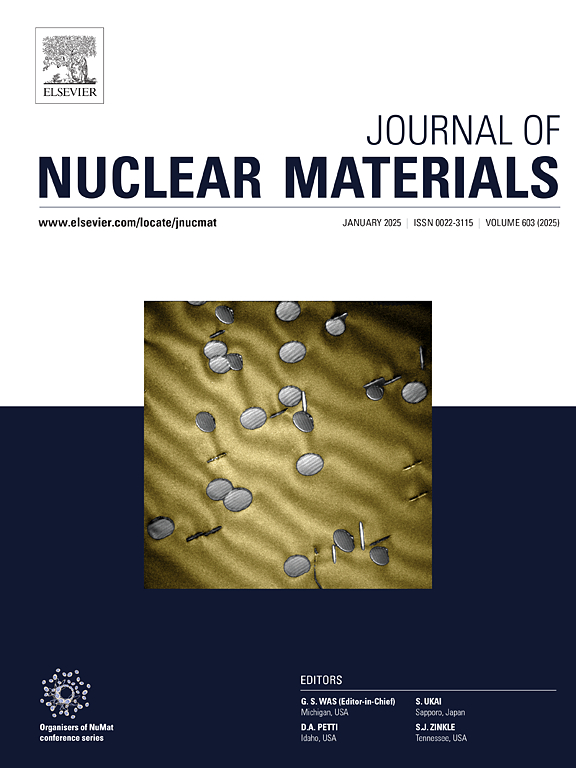The probable radiation-induced precipitate hcp-Re in heavy ion irradiated Mo-42Re alloy
IF 2.8
2区 工程技术
Q3 MATERIALS SCIENCE, MULTIDISCIPLINARY
引用次数: 0
Abstract
Molybdenum-rhenium (Mo-Re) alloys are regarded as important candidate structural materials for nuclear reactors. Apart from the known χ phase, limited research has been conducted on other precipitate phases, particularly hcp-Re. In this study, the Mo-42Re (wt. %) alloy was irradiated using 20 MeV Ni+3 ions at 853 K, reaching a maximum dose of 140 dpa. Five indirect evidences supported that there is a kind of phase different from the χ phase and that it is probable to be hcp-Re. Distinct radiation-induced precipitation (RIP) phenomenon is observed, with the χ phase commonly appearing as a radiation-induced precipitate and two shapes of probable hcp-Re. The two shapes of hcp-Re are the needle-like hcp-Re formed during growth and the small, near-equiaxed hcp-Re formed during nucleation. Explaining the different shapes of hcp-Re from the perspectives of nucleation and growth may help clarify past debates on the existence and morphology of hcp-Re.
重离子辐照Mo-42Re合金中可能的辐射诱发沉淀hcp-Re
钼铼(Mo-Re)合金是一种重要的候选核反应堆结构材料。除了已知的χ相外,对其他析出相,特别是hcp-Re进行了有限的研究。在本研究中,Mo-42Re (wt. %)合金在853 K下使用20 MeV Ni+3离子辐照,最大剂量达到140 dpa。五个间接证据支持存在一种不同于χ相的相,很可能是hcp-Re。观察到明显的辐射诱导沉淀(RIP)现象,χ相通常表现为辐射诱导沉淀和两种形状的可能的hcp-Re。hcp-Re的两种形状分别是生长过程中形成的针状hcp-Re和成核过程中形成的小而近等轴的hcp-Re。从成核和生长的角度解释hcp-Re的不同形状可能有助于澄清过去关于hcp-Re存在和形态的争论。
本文章由计算机程序翻译,如有差异,请以英文原文为准。
求助全文
约1分钟内获得全文
求助全文
来源期刊

Journal of Nuclear Materials
工程技术-材料科学:综合
CiteScore
5.70
自引率
25.80%
发文量
601
审稿时长
63 days
期刊介绍:
The Journal of Nuclear Materials publishes high quality papers in materials research for nuclear applications, primarily fission reactors, fusion reactors, and similar environments including radiation areas of charged particle accelerators. Both original research and critical review papers covering experimental, theoretical, and computational aspects of either fundamental or applied nature are welcome.
The breadth of the field is such that a wide range of processes and properties in the field of materials science and engineering is of interest to the readership, spanning atom-scale processes, microstructures, thermodynamics, mechanical properties, physical properties, and corrosion, for example.
Topics covered by JNM
Fission reactor materials, including fuels, cladding, core structures, pressure vessels, coolant interactions with materials, moderator and control components, fission product behavior.
Materials aspects of the entire fuel cycle.
Materials aspects of the actinides and their compounds.
Performance of nuclear waste materials; materials aspects of the immobilization of wastes.
Fusion reactor materials, including first walls, blankets, insulators and magnets.
Neutron and charged particle radiation effects in materials, including defects, transmutations, microstructures, phase changes and macroscopic properties.
Interaction of plasmas, ion beams, electron beams and electromagnetic radiation with materials relevant to nuclear systems.
 求助内容:
求助内容: 应助结果提醒方式:
应助结果提醒方式:


